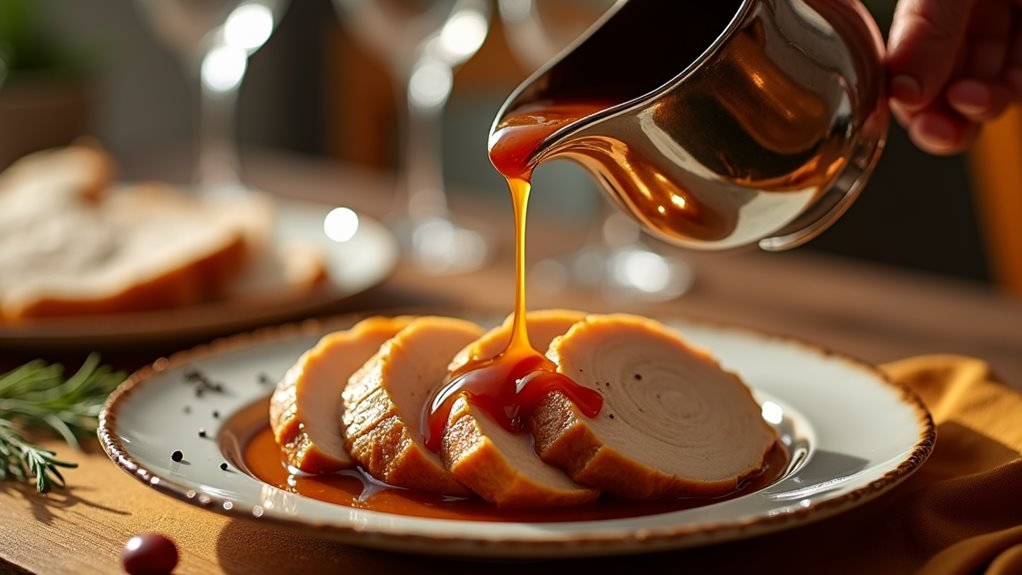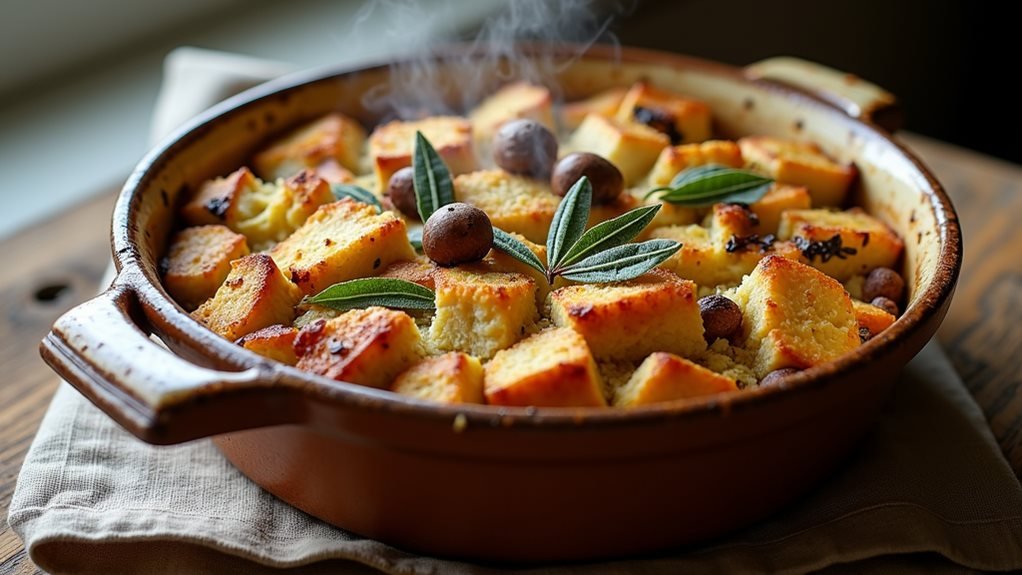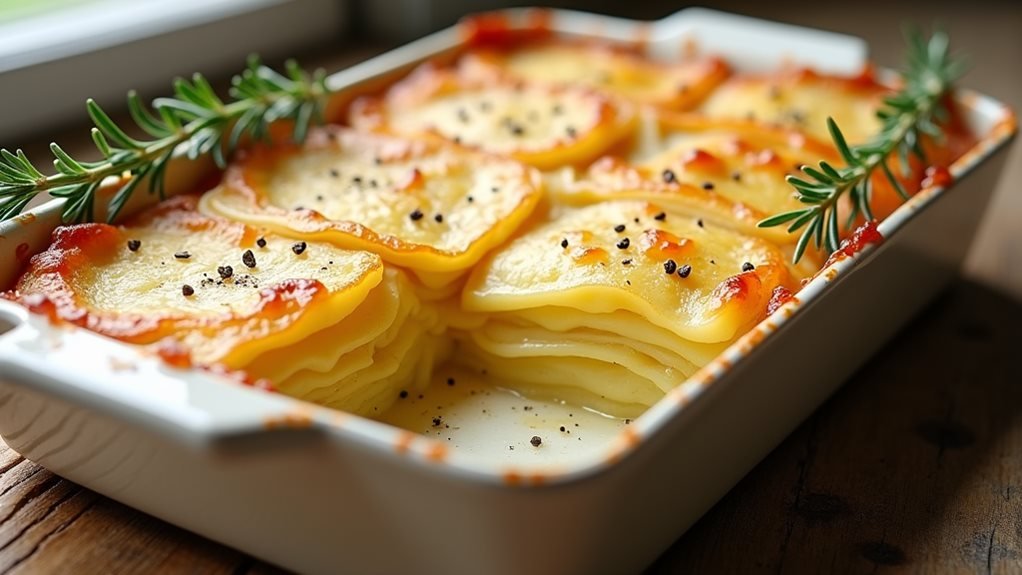Just as you’ve perfected your family’s traditional turkey recipe, you’ll find that Gordon Ramsay‘s red wine and shallot gravy can transform your Thanksgiving table into a culinary masterpiece. You won’t believe how the simple addition of caramelized shallots and reduced wine creates layers of complexity that enhance this sauce beyond ordinary pan drippings. While your guests might expect the usual brown gravy, they’ll be intrigued by the sophisticated depth of flavor that awaits them. The technique behind this upgraded version holds secrets that will change how you approach gravy-making forever.
Recipe Insights
- Caramelized shallots and dry red wine create sophisticated flavors that elevate traditional turkey-dripping gravy for an elegant Thanksgiving presentation.
- Strain shallots and whisk flour into drippings to form a smooth roux before adding wine for optimal texture.
- Cabernet Sauvignon provides robust depth while maintaining traditional roasted notes in the finished gravy.
- Reduce wine completely before adding stock to develop complex flavors and ensure alcohol cooks off entirely.
- Strain the finished gravy through a fine sieve for a silky consistency and serve in a proper gravy boat.
History
Wine-based gravies emerged from early European cooking methods, where cooks discovered that reducing wine with meat drippings created deeper, more intricate flavors. This method dates back to medieval French cuisine, where chefs in noble households would enrich their sauces with locally produced wines to elevate simple meat dishes.
As you delve into the evolution of gravy-making, you’ll notice that the addition of shallots became prominent during the 17th century, when French cuisine began to refine its approach to sauce-making. The practice crossed the Atlantic with European settlers, though early American gravies typically relied on water or broth rather than wine due to limited resources.
You’ll unearth that the modern red wine and shallot gravy gained popularity in the 1960s when Julia Child introduced Americans to sophisticated French cooking techniques. This style of gravy-making transformed traditional Thanksgiving preparations, offering home cooks a way to create restaurant-quality sauces. Today, you’ll see this method featured in countless cooking shows and magazines, solidifying its place as a contemporary holiday classic. Similar to Gordon Ramsay’s risotto cooking technique, the key to perfecting wine-based gravies lies in patient, attentive stirring and gradual liquid incorporation.
Recipe
Red wine and shallot sauce is a refined twist on traditional Thanksgiving gravy that turns ordinary turkey drippings into an exceptional condiment. The blend of caramelized shallots and reduced wine creates profound, intricate flavors that enhance any holiday meal.
This recipe utilizes the natural pan drippings from your roasted turkey, mixing them with dry red wine and carefully cooked shallots. The outcome is a smooth, indulgent sauce that harmonizes the delicate sweetness of caramelized shallots with the richness of reduced wine, all while enhancing the natural flavors of the turkey.
- 2 large shallots, finely chopped
- 2 cups turkey drippings
- 1 cup dry red wine (Cabernet Sauvignon)
- 2 cups turkey or chicken broth
- 2 tablespoons all-purpose flour
- Salt and pepper to taste
Warm turkey drippings in a large saucepan over medium heat and sauté shallots until golden brown, approximately 5-6 minutes. Sprinkle flour over the shallots and cook for 1 minute, stirring constantly. Pour in red wine and simmer until reduced by half, scraping the bottom of the pan to release browned bits. Gradually whisk in broth and simmer for 10-15 minutes, stirring occasionally until the sauce reaches the desired thickness. Season with salt and pepper to taste.
For the silkiest consistency, strain the completed sauce through a fine-mesh sieve before serving. Like Gordon Ramsay’s mulled wine recipe, this sauce benefits from deportation, allowing the flavors to develop fully. The sauce can be prepared up to two days in advance and stored in a sealed container in the refrigerator. When reheating, gently warm over low heat, whisking occasionally and adding additional warm broth if necessary to achieve the desired texture. If the sauce thickens too much during cooking, dilute it with extra warm broth; if it’s too thin, continue simmering until it thickens to the desired consistency.
Cooking Steps
You’ll want to strain the shallots before cooking and whisk the flour into the warm drippings until smooth.
Next, pour in your wine and let it reduce by half while stirring occasionally to release the tasty browned bits from the pan’s bottom.
Ultimately, add your stock and simmer until thickened, then strain the entire mixture through a fine-mesh sieve for that perfectly silky finish.
Step 1. Strain Shallots Before Cooking
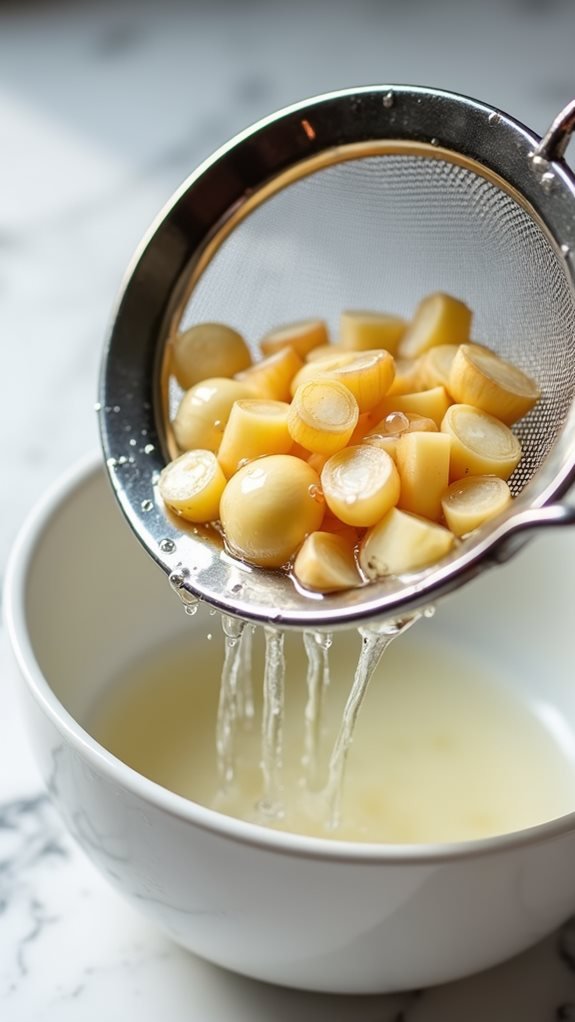
Before cooking, strain your diced shallots through a fine-mesh sieve and gently pat them dry with a kitchen towel. This crucial step eliminates excess moisture that could affect proper caramelization and helps guarantee your gravy achieves the ideal thickness. You’ll observe that properly strained shallots develop a deeper golden hue and more intensified flavor during cooking.
After straining, inspect your shallots closely to eliminate any thin outer layers that may have slipped through the dicing process. These pieces can create undesired texture in your ultimate gravy. If you’re working with notably large shallots, you might want to give them an additional quick chop to ensure consistent size, which facilitates uniform cooking. Don’t overlook this preparation step, as damp shallots will steam instead of caramelize, hindering the creation of those intricate flavors that set this gravy apart.
Remember to organize your sieve and kitchen towels before you start dicing the shallots. You’ll need to process them promptly to prevent oxidation, which can result in unwelcome bitterness in your completed gravy.
Step 2. Whisk Flour Into Drippings
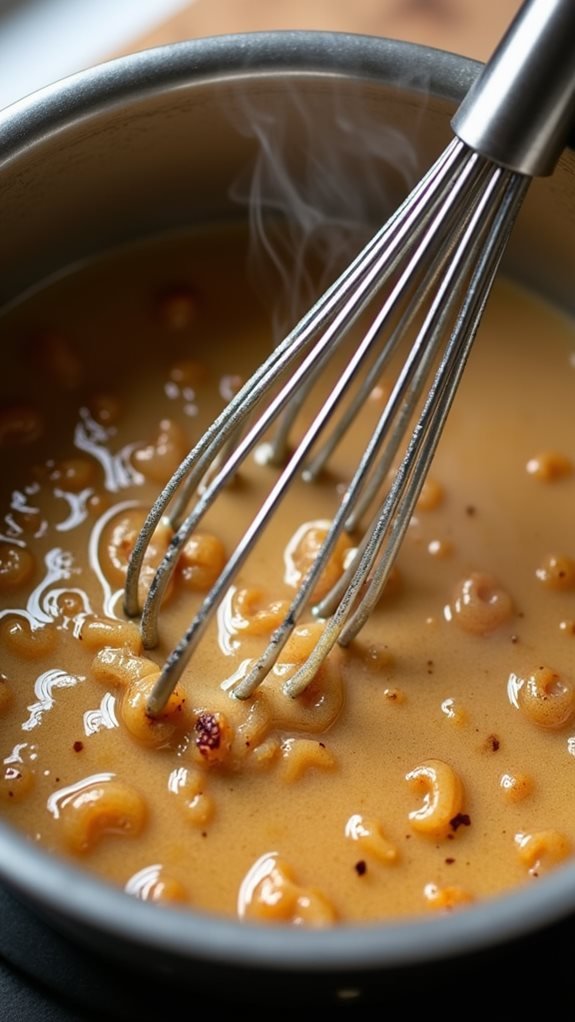
The gravy’s foundation begins with a vital step: whisking flour into hot turkey drippings to create a smooth roux. You’ll want to sprinkle the flour gradually over the drippings and shallot mixture, whisking continuously to prevent any clumps from forming. This technique guarantees your roux develops properly, creating the base for a silky-smooth gravy.
As you incorporate the flour, you’ll notice the mixture becoming paste-like in consistency. Don’t worry—this is precisely what you want. Keep whisking steadily for about 60 seconds, allowing the flour to cook through and lose its raw taste.
You’ll know you’re on the right path when the roux takes on a slightly nutty aroma and develops a golden-brown color.
The secret here is patience and attention to detail. If you rush this step or don’t whisk consistently, you risk developing flour clumps that will be challenging to remove later. Remember, you’re building layers of flavor, and this vital step sets the stage for incorporating the wine and stock that will transform your gravy into something extraordinary.
Step 3. Add Wine and Reduce

With your roux perfectly whisked and golden, it’s time to add the red wine. Pour one cup of Cabernet Sauvignon into your pan, letting the rich aroma fill your kitchen as you scrape the bottom with a wooden spoon to release any caramelized bits. These browned pieces contain concentrated flavors that will enrich your gravy’s depth and complexity.
Let the wine reduce by half, which typically takes 5-7 minutes at medium heat. You’ll notice the liquid becoming more concentrated and slightly syrupy – this is precisely what you’re looking for. During this reduction process, the alcohol cooks off while the wine’s intricate flavors intensify. Don’t rush this step; proper reduction ensures you won’t taste any harsh alcohol notes in your final gravy.
As the wine reduces, you’ll see it bubbling gently around the edges of the pan. The color will deepen, and the liquid will coat the back of your spoon more substantially.
Once it’s reduced properly, you’ve created the perfect base for adding your stock in the next step, setting you up for a sophisticated, restaurant-quality gravy.
Step 4. Add Stock and Simmer
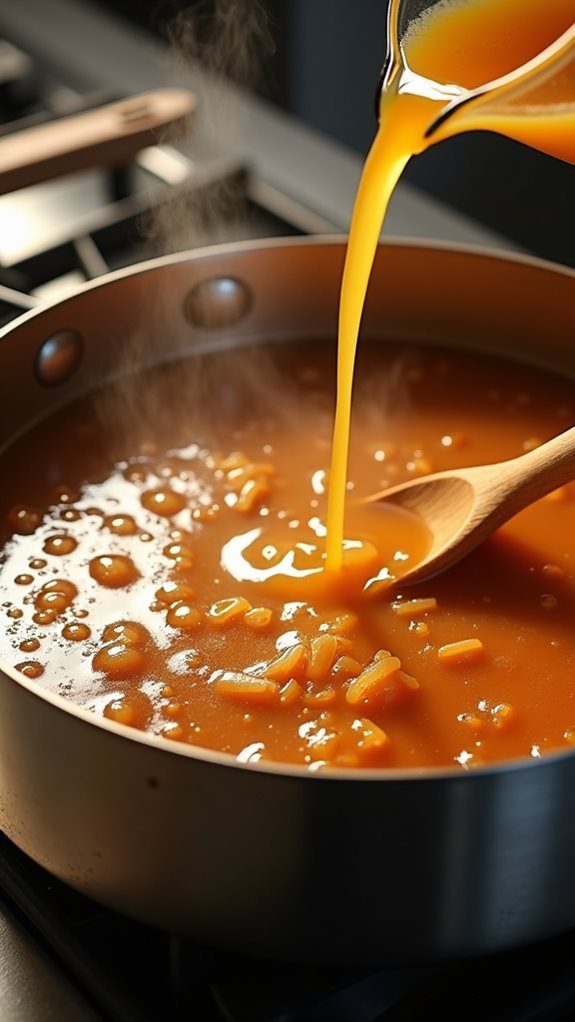
Now that your wine has decreased perfectly, slowly pour in two cups of turkey or chicken broth while whisking continuously. You’ll notice the mixture beginning to thicken as the flour combines with the liquid, creating that silky texture you’re aiming for. Keep whisking to prevent any lumps from forming during this pivotal step.
Let the gravy simmer for 10-15 minutes, stirring occasionally to guarantee even cooking throughout. During this time, you’ll see the gravy gradually thicken to the ideal consistency. If it’s becoming too thick, don’t hesitate to add a bit more warm broth, about a quarter cup at a time.
Conversely, if your gravy’s too thin, continue simmering until it reaches your desired thickness.
For the smoothest possible finish, strain the gravy through a fine-mesh sieve before serving. This step removes any remaining bits of shallot and guarantees a velvety texture that’ll perfectly coat each bite of turkey.
You can keep the gravy warm in a covered saucepan until ready to serve, or you can refrigerate it for up to two days and gently reheat it when needed.
Step 5. Strain Through Fine Sieve
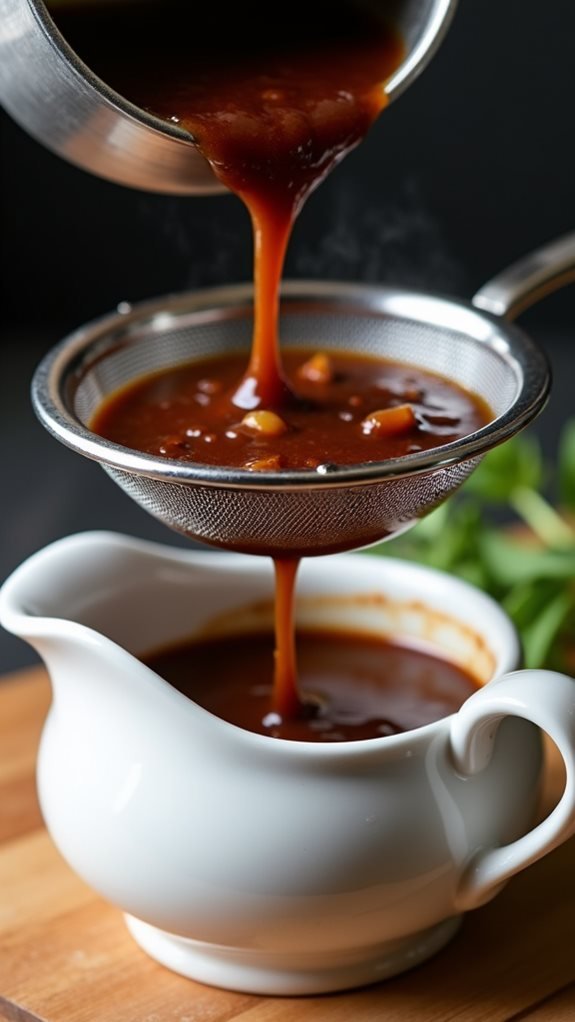
For a perfectly smooth sauce, position a fine-mesh strainer over a clean saucepan or serving container. Carefully pour your wine-enriched sauce through the strainer, allowing it to filter naturally without pressing. The strainer will catch any remaining shallot pieces and potential flour lumps, guaranteeing your final dish attains restaurant-quality smoothness.
If you’re working with a larger batch, you might need to filter in portions to prevent overflow. Keep thfilterer raised slightly above the collection container to maintain proper flow. Once filtered, gently whisk the sieved sauce to ensure uniformity and adjust the seasoning if necessary. The resulting consistency should be silky and consistent, without any particles that might detract from your perfectly cooked poultry.
Don’t dispose of those filtered shallot pieces right away – they’re filled with flavor and can be reused. You can spread them on crusty bread or add them to stuffing.
After straining, keep your sauce warm until serving, covering it with a lid or a piece of parchment paper to prevent a film from forming on top.
Common Questions About This Recipe
Many home cooks encounter common questions while preparing this sophisticated gravy recipe for the first time. You’ll likely ponder over wine selection, with Cabernet Sauvignon being ideal due to its robust flavor profile and ability to withstand reduction. If you’re worried about alcohol content, rest assured that the cooking process eliminates it
Another frequent query involves the consistency of the gravy. If you notice lumps forming while adding the flour, whisk more vigorously and consider straining the final product.
If you want to prepare this gravy in advance, you can refrigerate it for up to 48 hours—just reheat it gently over low heat, whisking occasionally to restore its silky texture.
You might also wonder whether you can substitute ingredients. While pearl onions can replace shallots, they won’t provide the same depth of flavor. For those lacking turkey drippings, you can use butter as a base, though you’ll sacrifice some of the traditional roasted notes. Remember to taste and adjust seasoning throughout the cooking process, as reduced wine can intensify saltiness.
Final Thoughts and Serving Ideas
This elegant gravy‘s versatility extends beyond the traditional turkey pairing. It’s equally delightful drizzled over roasted potatoes, spooned onto stuffing, or served alongside your favorite meat dishes throughout the holiday season. The rich, wine-infused sauce adds sophistication to everyday meals, transforming simple roasted chicken or pork tenderloin into restaurant-worthy entrées.
For the best serving, keep the gravy warm in a classic gravy boat or small slow cooker set to low. If you’re hosting a buffet-style meal, consider placing several smaller gravy boats along the table for easy access.
Don’t forget to provide a proper ladle or gravy spoon to guarantee tidy pouring and prevent spills on your tablecloth.
When storing leftovers, transfer the cooled gravy to an airtight container and refrigerate for up to five days. You can easily refresh it by whisking in a small amount of warm stock while reheating over low heat.
The gravy’s flavors often deepen after a day or two, making it an excellent make-ahead option for busy hosts.
